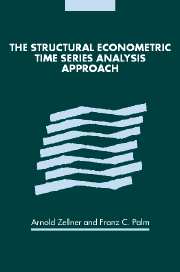Book contents
- Frontmatter
- Contents
- List of contributors
- Acknowledgments
- Introduction
- Part I The SEMTSA approach
- Part II Selected applications
- 6 Time series and structural analysis of monetary models of the US economy (1975)
- 7 Time series versus structural models: a case study of Canadian manufacturing inventory behavior (1975)
- 8 Time series analysis of the German hyperinflation (1978)
- 9 A time series analysis of seasonality in econometric models (1978)
- 10 The behavior of speculative prices and the consistency of economic models (1985)
- 11 A comparison of the stochastic processes of structural and time series exchange rate models (1987)
- 12 Encompassing univariate models in multivariate time series: a case study (1994)
- Part III Macroeconomic forecasting and modeling
- Part IV Disaggregation, forecasting, and modeling
- Subject index
- Author index
- References
8 - Time series analysis of the German hyperinflation (1978)
Published online by Cambridge University Press: 24 October 2009
- Frontmatter
- Contents
- List of contributors
- Acknowledgments
- Introduction
- Part I The SEMTSA approach
- Part II Selected applications
- 6 Time series and structural analysis of monetary models of the US economy (1975)
- 7 Time series versus structural models: a case study of Canadian manufacturing inventory behavior (1975)
- 8 Time series analysis of the German hyperinflation (1978)
- 9 A time series analysis of seasonality in econometric models (1978)
- 10 The behavior of speculative prices and the consistency of economic models (1985)
- 11 A comparison of the stochastic processes of structural and time series exchange rate models (1987)
- 12 Encompassing univariate models in multivariate time series: a case study (1994)
- Part III Macroeconomic forecasting and modeling
- Part IV Disaggregation, forecasting, and modeling
- Subject index
- Author index
- References
Summary
Introduction
Historical studies of periods of rapid and sustained inflation as well as empirical studies of the demand for and supply of money have convinced monetarists that a strong link exists between money and prices. Indeed, Friedman (1968) has argued that movements in the money supply dominate movements in the price level.
One study that monetarists have often cited as strong evidence for this link between money and prices is Phillip Cagan's [1956] study of hyperinflations. With data on the money supplies and price levels of six countries in the throes of hyperinflation, Cagan finds that the hyperinflations were apparently caused by the pressure of a rapidly growing and exogenous money supply against a stable demand for real money balances. Unfortunately, the statistical procedures available to Cagan did not enable him to test the specification of his model adequately. In particular, he tested neither his specification of the mechanism generating expected inflation rates nor his specification of an exogenous money supply. Indeed, he failed even to test for serial correlation of the error terms. The Monte Carlo experiments of Granger and Newbold (1974) amply demonstrate that the goodness of fit of a regression is often greatly over-stated when serial correlation is present in the error term. It is therefore desirable to reassess Cagan's study.
In this chapter, I apply the technique advocated by Zellner and Palm (1974, 1975) to test three specifications of the dynamics of the German hyperinflation:
Model C, Cagan's original model;
Model MC, a modification of Cagan's original model in which expectations of inflation are rational in the sense of Muth (1961); and
[…]
- Type
- Chapter
- Information
- The Structural Econometric Time Series Analysis Approach , pp. 315 - 331Publisher: Cambridge University PressPrint publication year: 2004

